
9653;



9653;

Civil Engineering Department, Institute of Technology, Nirma University, Ahmedabad, Gujarat 382481

Abstract: A promising sustainable method for generating energy from municipal, industrial, and animal wastes is biogas. The development of biogas can be combined with plans to enhance sanitation, lessen indoor air pollution, and cut greenhouse gas emissions. In addition to providing a techno economic feasibility analysis of biogas plants, this research intends to identify technical and non-technological constraints preventing the widespread use of biogas in India. Different waste, renewable energy, and urban regulations have an impact on the distribution of biogas. Therefore, specific obstacles to India's current rural and urban biogas systems were identified. The findings demonstrate that there are significant differences in the nature and significance of obstacles amongst biogas systems due to variations in technological maturity, feedstock quality and availability, supply chain, awareness level, and policy support. The developed excel model also provides a full perspective of the economic factors used to assess the viability of a biogas plant project. Users may assess numerous situations and decide on the best course of action for their investment in the biogas sector by using a comparison and analysis technique.
Biogas may play a role in the shift to a more environmentally friendly energy system. Modern waste management systems may benefit from the use of biogas, a sustainable energy source. Producing biogas can also aid in returning nutrients to crops. In addition to all of this, biogas is a locally generated energy source that has the potential to boost the efficiency of the use of global resources since it may result in increased value and decreased waste, as well as reduced adverse environmental consequences. Nevertheless, biogas production systems are complicated due to the variety of substrates, uses for digestate and biogas, and technological approaches for digestion, pre treatment, and upgrading raw gas. There is a growing amount of energy demand in India from many industries. Biomass, which is one of the main energy sources in rural India and makes up around 75% of total energy consumption, is currently the new prospect in national programmes for a competitive energy source [1,2]. Due to its ecological sustainability and great efficiency, bioenergy, a major renewable energy source, is crucial in lowering carbon emissions [3]. Bioenergy differs from other renewable energy sources in several ways. As long as the utilization rate is lower than the growth rate, there are significant amounts of biomass feedstock that are available and stored on Earth. As a result, biomass may end up being the only organic resource that is renewable for making energy [4]. The carbon dioxide emissions from using bioproducts can also be countered by the carbon dioxide fixation and absorption from the regeneration of biomass resources since biomass is a biological substance obtained from living or recently lived organisms. Therefore, biomass utilization can realize carbon neutrality goals [5]. In addition, bioenergy can be converted into various types of energy carriers, such as biodiesel, biogas, and bioethanol, which could facilitate easier storage and utilization of such energy [6,7]. Thereby, biomass utilization follows the “waste to energy” model and is beneficial for establishing a sound material cycle society.
Individual homes often operate small scale plants to produce energy for self use. On the other hand, large scale biogas facilities that can produce more than 5000 m3 of biogas per day mostly use municipal sewage organic wastes to produce biogas, which may then be used to generate electricity, heat homes and businesses, and power vehicles. Large scale commercial biogas plants are managed by entirely private or public private partnerships to yield financial benefits through the sale of end products such as electricity, transport fuel, or heat. Family type biogas plants are managed by individual households and require financial investment while only yielding non monetary benefits, such as biogas used as a cooking fuel instead of gathered fuelwood. Uncontrolled urbanization and the rapid pace of population expansion have seriously complicated the challenge of disposing of solid garbage. Food waste makes up a significant component of municipal solid wastes (MSWs), which are frequently dumped in landfills or other places and cause environmental issues, according to a study conducted by Baawain et al. [20]. However, because landfilling produces leachate, methane, and carbon dioxide as well as other annoyances like insects, odor, and vermin like birds and rats, it is expensive, takes up a lot of areas, and may have a severe influence on the environment if improperly managed.
Engineering Technology (IJRASET

ISSN: 2321 9653; IC Value: 45.98; SJ Impact Factor: 7.538 Volume 10 Issue IX Sep 2022 Available at www.ijraset.com
Along with the release of methane, a strong greenhouse gas with a short term global warming potential 84 times greater than carbon dioxide, leachate might potentially damage soil and subsurface water [21,22,23].
Knowledge exchange is a crucial component in the growth of biogas producing systems. Clear analyses and comparisons of biogas producing systems are required to promote this information exchange. Therefore, research is required to confirm the resource productivity of biogas production environments from many angles. The purpose of this project is to identify and assess technical and economic barriers to biogas production to develop capital and operational cost profile and estimate the potential economic feasibility of the biogas production process for achieving its commercial viability.
While there have been some studies concentrating on biogas in particular locations and hurdles to renewable energy in general, there is a dearth of information on the full scope of these barriers and the techno economic viability of commercializing biogas energy. This initiative intends to close this gap and act as a roadmap for those making investment and adoption decisions in biogas energy.
In addition to producing energy and manure, the anaerobic digestion of biodegradable organic wastes has several positive social and environmental effects. The release of local air pollutants like dioxins and furans, as well as methane, a powerful greenhouse gas, are all negative externalities linked to organic wastes that biogas helps to mitigate [8,9].
One of the most popular methods for handling organic municipal solid waste (MSW) is anaerobic digestion (AD), which may produce biogas and methane as alternatives to natural gas and liquid petroleum gas (LPG). After the AD process is complete, the residue is a stabilized organic substance that may be used immediately on agricultural land as a bio fertilizer (without ripening beforehand). This can replace synthetic or mineral fertilizers and provide the opportunity for nutrient recycling (nitrogen and phosphorus). Consequently, AD of bio waste combines energy generation with advantages for the environment.
The efficiency of AD throughout the biodegradation process, which improves while running at peak performance, is crucial to the generation of biogas. Temperature, organic loading rate, pre treatment, inoculum, feeding pattern, hydraulic retention duration, and pH are significant parameters that affect biogas generation and have a significant impact on the AD process [19]. As biogas is created by four categories of microorganisms fermentative, syntrophic, acetogenic, and methanogenic bacteria the microbial population and type of microbes have a major impact on AD and the composition of the gas [24,25].

These bacteria often exist in the natural environment and serve various functions in the anaerobic decomposition of garbage. Different varieties of microorganisms require various environmental conditions to exist. A kind of organism known as mesophilic bacteria thrives at temperatures between 20 and 45 °C, with 35 °C being the ideal temperature [27]. Thermophilic conditions typically occur between 50 and 65 °C, with 55 °C being ideal [28]. In contrast, thermophilic bacteria are a kind of organism that thrives and lives best in relatively hot temperatures (temperature range 41 122 °C). Microorganisms are essential to the breakdown of organic compounds and are crucial to the anaerobic degradation process [29]. Mesophilic AD is more stable than thermophilic digestion, according to the volumetric quantity of biogas generated in various digesters during the digestion process [30].
The use of biogas for energy production, power generation, and transportation in underdeveloped nations still requires improvement on all scales, from small scale (home or domestic implementation) to large scale implementation. For biogas to be used to its full potential in underdeveloped nations, there are issues with legislation, money, technical services, sustainability, awareness, and education [10].
There have been initiatives to advance biogas technology since the 1970s. The first oil crisis in the early 1970s showed Indian officials that commercial energy would continue to be out of the financial grasp of the poor in both the rural and urban areas [11]. India imported more oil products than it exported. In addition to increasing the pressure on the national budget to pay for rising energy subsidies for domestic fuels, especially kerosene, used by the rural and urban poor for very basic cooking and lighting needs, the combination of the global energy crisis and local energy shortages increased the risk to the country's energy security.
Based on the review, it was found that barriers differ in different regions depending on the degree of market maturity and availability of natural resources like biomass, land, and water. Barriers such as low ambient temperature and water unavailability in arid regions are area specific whereas others are specific to technological scale like lack of distribution infrastructure hindering the biogas expansion in a centralized system [31,32]. Socio cultural barriers like objections toward using animal and human waste as raw materials are very specific to the local values and culture [33]
Cooking, lighting, and power production using clean fuels like biogas instead of fossil fuels and untreated conventional solid biomass would also assist reduce GHG emissions and indoor air pollution [12]. Numerous research has been done to evaluate technical advancements that increase biomass output, including physiochemical (extraction, carbonization), thermochemical (gasification, pyrolysis), and biochemical (anaerobic digestion) technologies [13,14].
International
Science
Engineering Technology (IJRASET
ISSN: 2321 9653; IC Value: 45.98; SJ Impact Factor: 7.538 Volume 10 Issue IX Sep 2022 Available at www.ijraset.com
In terms of techno economic factors, such as energy usage, efficacy, and cost [15], Kamusoko et al. (2019) examined the effectiveness of biological, chemical, physical, and combination pre treatments in enhancing biomethane synthesis from agricultural wastes. Additionally, Tabatabaei et al. 2020a and 2020b thoroughly assessed biological advancements and improvements in biogas production from three perspectives: upstream, mainstream, and downstream techniques, respectively [16]. The development of the biogas industry is influenced by a wide range of political, economic, and social variables, including regulations in the areas of energy, the environment, agriculture, banking, and education, among others. Both effective coordination between the decision makers from the aforementioned domains and active participation of the professionals and associations of profile in the process of policy creation is necessary for the growth of this relatively new economic sector [26].
The literature research is provided by the co digestion economic analysis tool to prepare the MS Excel model for the techno economic feasibility assessment. It was produced by the US Environmental Protection Agency. It is intended for those in decision making positions who have technical expertise in anaerobic digestion, such as municipal managers, engineers, and anaerobic digestion system operators. Users can use it to assess the advantages and disadvantages of accepting and processing food waste, fats, oils, and greases (FOG), or other organic resources. It makes use of information and certain parameters from the institution being assessed. The application produces economic and operational statistics to help customers better understand the effects and costs of digesting various types of feedstocks at their plant. The data contains:
1) Fixed and recurring costs
2) Solid waste diversion savings
3) Capital investments
4) Biogas production and associated energy value
The challenges preventing the widespread distribution of biogas on a big scale in urban India have been studied. In depth interviews with chosen stakeholders were thus performed in addition to the literature research to get the knowledge necessary to comprehend the underlying causes of each obstacle, particularly about the distribution of biogas in urban areas. Based on the total literature analysis, open ended questions on hurdles and biogas policy were posed in a hierarchical order.
For the interviews, consultants and academics active in biogas projects of various sizes were chosen to better understand the main technological and market related hurdles that exist in India. To further understand the existing policy environment and degree of cooperation between the national and subnational governments, officials participating in biogas policy making processes at the national, state, and municipal levels of government were interviewed. Policymakers at the state and municipal levels in Gujarat were chosen for the interviews since this state was the first in India to declare a waste to energy program.
A qualitative and systemic approach was used to identify barriers to biogas penetration in India. The following steps were taken to extract the relevant literature. The penetration of biogas in India has been hindered, and this was determined using a qualitative and systematic method. The relevant literature was extracted using the procedures listed below.
a) First, a thorough search of research and review publications in the ASCE Library and Scopus database was done.

b) In addition to the literature study, interviews with specific stakeholders were performed to get the knowledge necessary to comprehend the underlying causes of each obstacle, particularly concerning the spread of biogas in India.
c) Conclusions on the difficulties with producing biogas in India were made based on the aforementioned processes.
d) Second, a review of previous studies and reference models was conducted to create an MS Excel model for the Techno Feasibility analysis of biogas plants.
e) The developed excel model will next be verified using information gathered from prior literature reviews or a case study of a biogas plant.
The level of technological advancement in the biogas industry varies greatly from one region to another and is influenced by a variety of variables, including the economic development of the nation, access to technology, the type and availability of feedstock, the need for the implementation of biogas technology, the education level of the populace, and their environmental awareness. As a result, depending on the market's level of development, different hurdles to the implementation of biogas projects may exist. While in moderate and immature markets, the main obstacles relate to the existence, stability, and dependability of the legal framework and support schemes, access to finance, absence of long term strategies, lack of training, and lack of educational support, the main obstacles in mature markets relate to the availability of feedstock, public perception, indirect land use change (ILUC), and sustainability issues [17, 18].















ISSN: 2321 9653; IC Value:

at www.ijraset.com




ISSN: 2321 9653; IC Value:
SJ Impact Factor: 7.538


at www.ijraset.com


The values that must be input by the user for options 1, 2, and 3 are shown in Fig. 6 In option 3, the amount of food waste must be manually input; however, in options 1 and 2, data will be generated based on the values that the user enters in the fields as shown in Fig 5.

The 'Feedstock Parameters' page will compute the estimated input feedstock for creating biogas if a known user can enter the rejection % of food waste owing to contamination, as per the number supplied here in Fig. 7.

ISSN: 2321 9653; IC Value: 45.98; SJ Impact Factor: 7.538

10 Issue
at www.ijraset.com

As seen in fig. 8, the calculation for Part 2's solid waste infrastructure is done for the region where food waste pickup is decided by giving each home a green bin, giving collecting bins to surrounding areas, etc. Fees for landfill dumping, feedstock access, pre processing, collection, etc. are also included in the transportation cost.


The user must also input additional digester information, such as cost, O&M expenses, the needed number of digesters, etc. If the user doesn't have access to this information, he or she can use the answers from "Feedstock Parameters" as a starting point to figure out digester sizing individually.

Part 3 is about financial data, as seen in fig. 9. To analyze their investment, users must provide financial information such as the discount rate and finance rate that they or their company will utilize. Additionally, the user must input current, the cost of electricity (per KWh), and the cost of natural gas (per MMBtu).

C.

International
Figure
ISSN: 2321 9653; IC Value:
Factor:

at www.ijraset.com

To compute the output
as the output food waste solids content

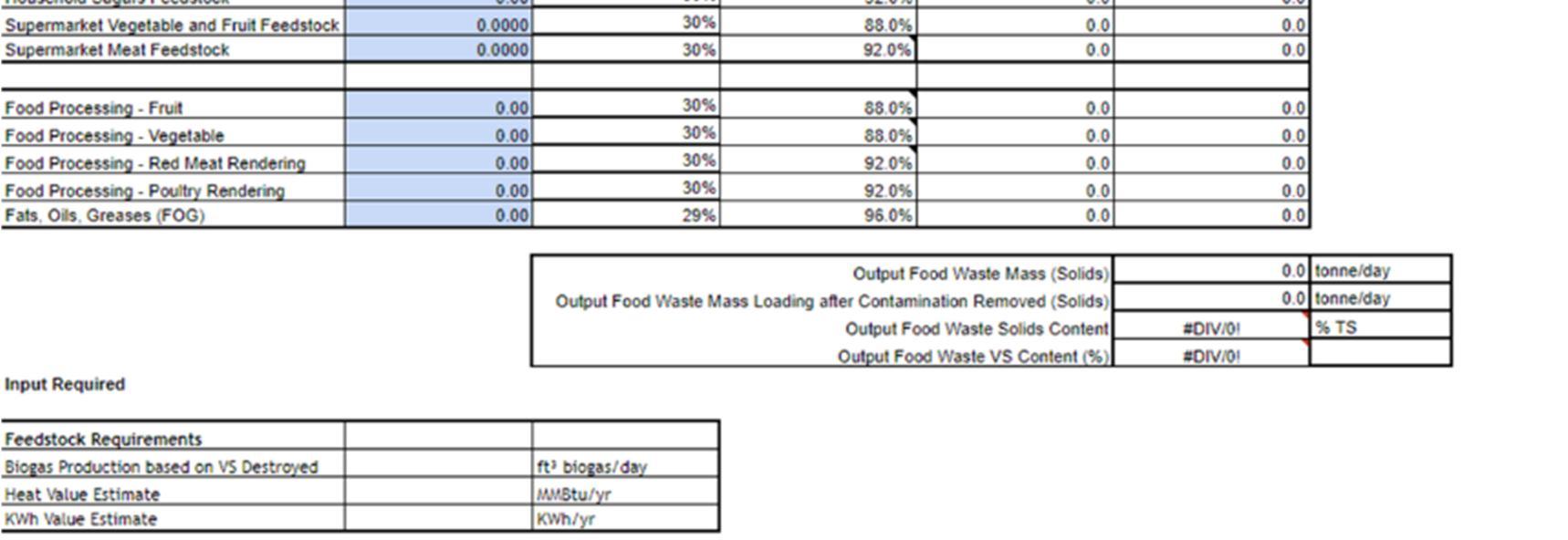

must first be taken into consideration as shown in Fig.
D.
ISSN:







ISSN: 2321 9653; IC Value: 45.98; SJ Impact Factor: 7.538

10
at www.ijraset.com
The worksheet determines the transportation and disposal expenses related to gathering and processing food waste feedstock and handling the resultant
as shown in Figs. 13 and 14. Infrastructure for collecting feedstocks, transportation, entrance fees, and tipping
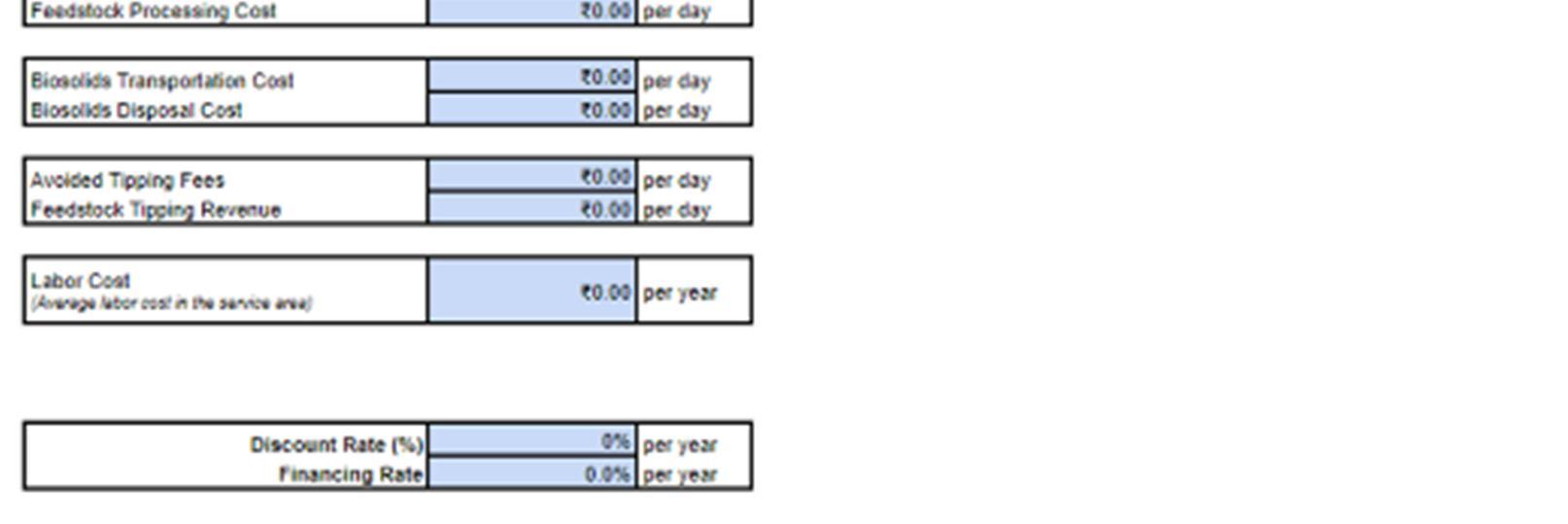

are all factors to be taken into account. The feedstock collecting system shall establish Feedstock Access Costs and Feedstock Transportation Costs.
F. Component: Financial Model Output (Sheet
Value (NPV) for the project using predicted future benefits from biogas

This worksheet projects cash flows and computes a Net
as well as capital
O&M
shown in Fig.

The main presumptions are the 15 year project timetable, the

rate
the user
the
page, and the substitution of biogas for natural gas in other applications.
International
Engineering Technology (IJRASET

ISSN: 2321 9653; IC Value: 45.98; SJ Impact Factor: 7.538 Volume 10 Issue IX Sep 2022 Available at www.ijraset.com
Many alternative situations, particularly those involving the utilization of biogas, are conceivable. Examples include steam generation and the cogeneration of electricity. Users can alter the data in the spreadsheets to alter the Model after they are comfortable with the inputs, outputs, and data utilized to generate values.
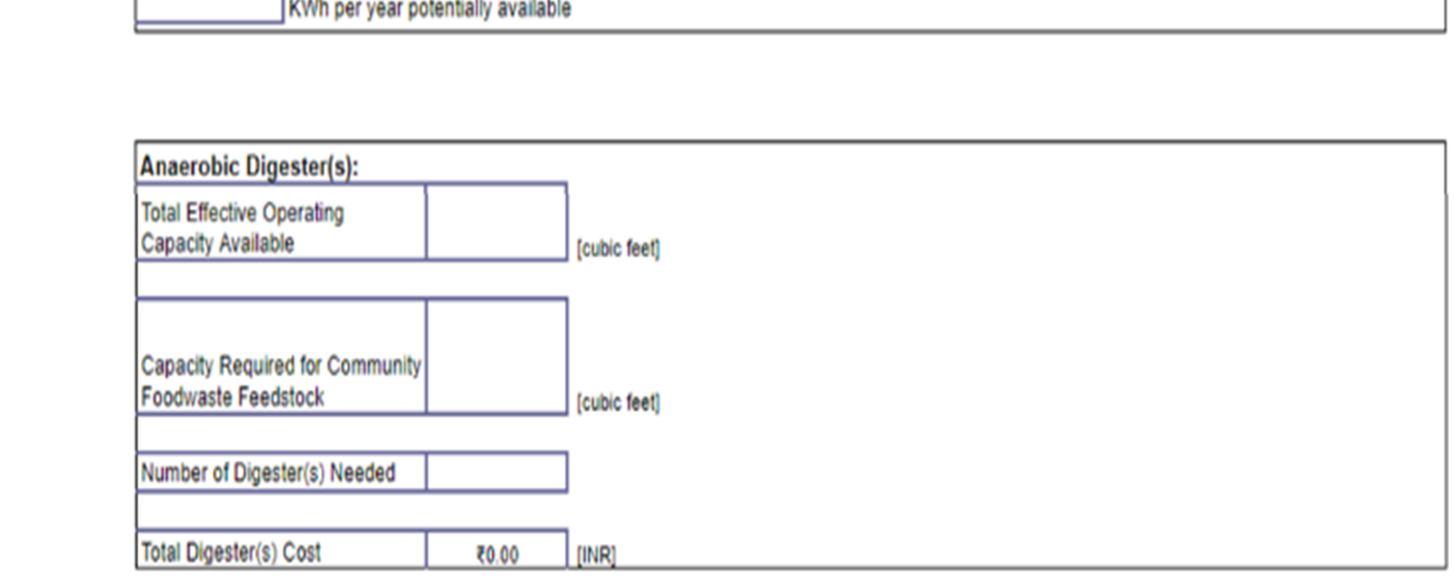

In Fig. 16, the viewer may obtain an overall picture of the investments made year by year and calculate the project's net benefit using NPV analysis.
G. Component: 1 Page Summary (Sheet 7) This sheet will summarize all the data for the user.


Fig. 17 displays an overview of organizational data and statistics on food waste.
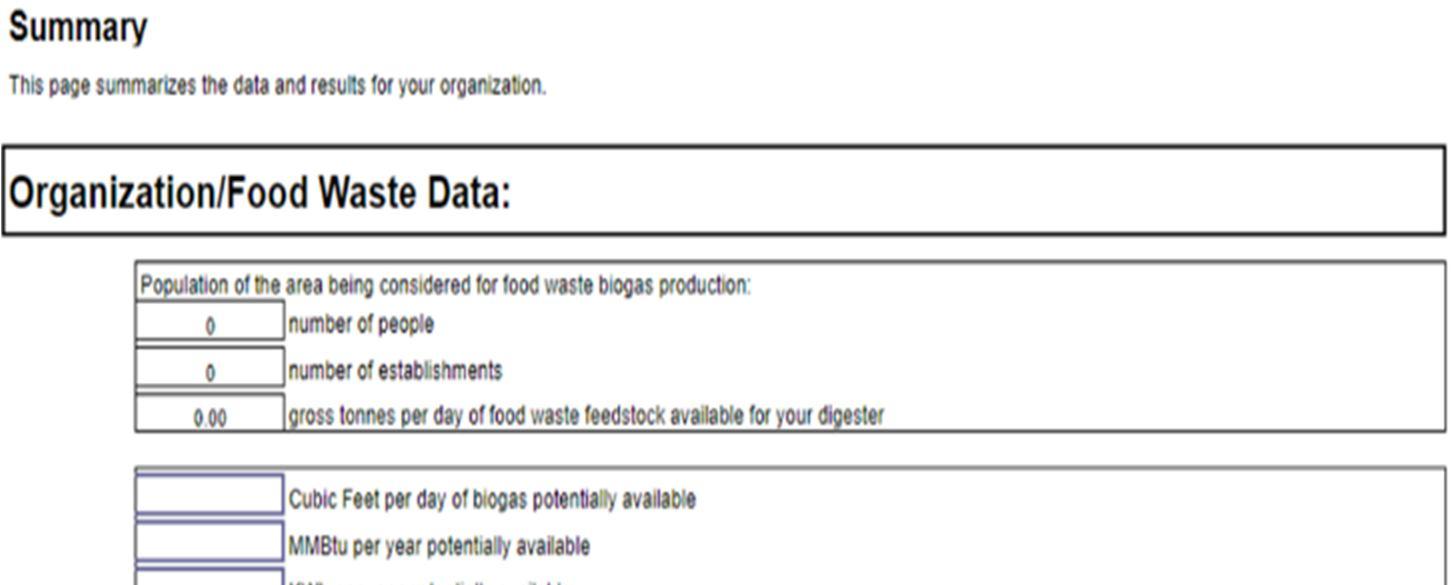
Technology (IJRASET
ISSN: 2321 9653; IC Value: 45.98; SJ Impact Factor: 7.538 Volume 10 Issue IX Sep 2022 Available at www.ijraset.com

Fig. 18 presents a financial summary. It contains all the information necessary for the user to make an investment choice, including digester costing, feedback collection system costs, total project costs, and net present values.

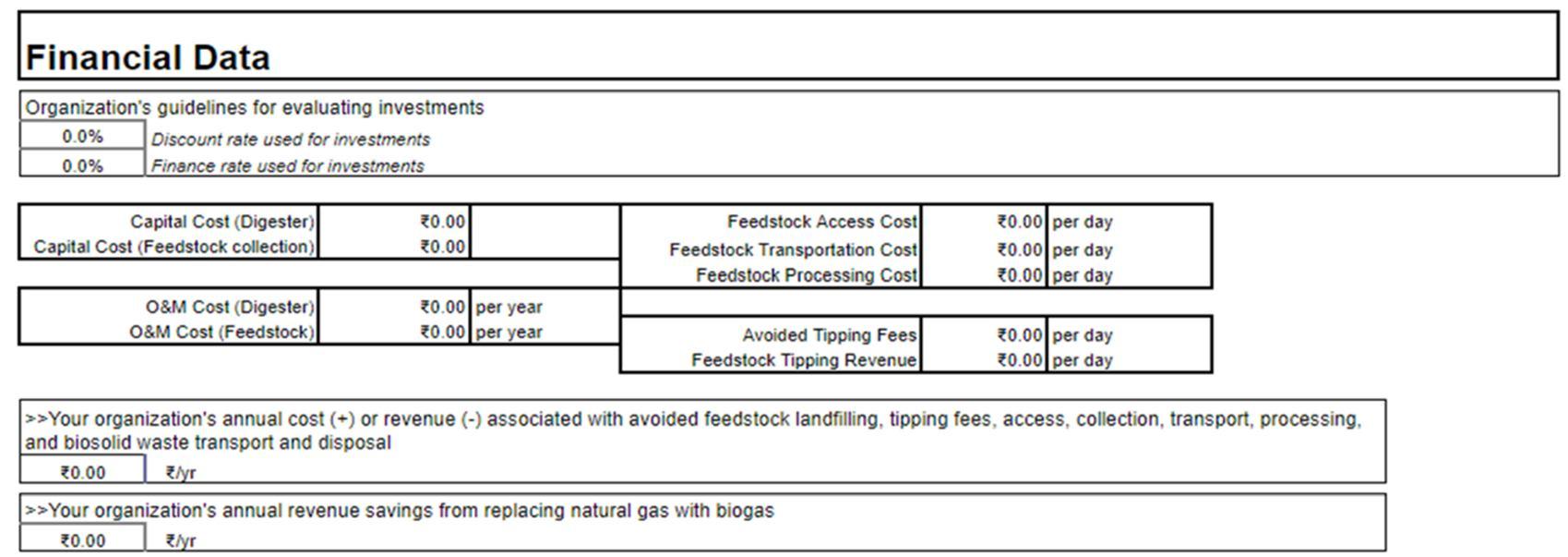
By contrasting the net yearly value of the present process with that of the future process with various biogas usage possibilities, it is possible to ascertain whether the economics of accepting external feedstocks is a worthwhile investment. While this is the major outcome, further inferences from the model can be made through comparative analysis.
Analyze how your present process will be affected by modifying the biosolids handling parameters. Other outcomes might be inferred from the model's output; this is not an exhaustive list.

Particularly in small towns, a sizable amount of garbage is made up of biomass wastes. Thus, it is crucial to use biomass waste as a recyclable resource to advance a society that values cycles. There are several known methods for using biomass wastes, including composting, making biogas, and generating energy. Several policy proposals are made for removing these barriers in light of our findings.
The majority of the population in rural regions lives in low and middle income families, creating a higher demand for clean, inexpensive energy. The upfront installation cost of the biogas plant is the main impediment to the deployment of rural biogas plants among these families. This project's main finding is:
1) The limited adoption of biogas technology in India is the consequence of several financial and nonfinancial hurdles that also differ from region to region and from urban to rural regions.
2) This project can serve as a manual for new entrants in the biogas business by combining information about difficulties encountered in biogas generation with the use of the provided Excel model.
3) The model was created to offer a method for determining if building a biogas plant would be economically feasible. It is adaptable to make it simple for the user to input personalized data and assess the outcomes.
To help reduce the variations in feedstock quality, which could eventually lead to the standardization of technologies for a certain quality and composition of the waste, proper regulations regarding the segregation of organic and inorganic wastes should be enforced on the generators in the long term.

ISSN: 2321 9653; IC Value: 45.98; SJ Impact Factor: 7.538

Volume 10 Issue IX Sep 2022 Available at www.ijraset.com
[1] Khuman YSC, Pandey R, Rao KS. Fuel wood consumption patterns in Fakot watershed, Garhwal Himalaya, Uttarakhand. Energy 2011;36:4769 76.
[2] Habib G. New methodology for estimating biofuel consumption for cooking: atmospheric emissions of black carbon and sulfur dioxide from India. Global Biogeochem Cycles 2004;18::Gb3007. http://dx.doi.org/10.1029/ 2003gb002157.
[3] Meisam Tabatabaei, Mortaza Aghbashlo, Elena Valijanian, Hamed Kazemi Shariat Panahi, Abdul Sattar Nizami, Hossein Ghanavati, Alawi Sulaiman, Safoora Mirmohamadsadeghi, Keikhosro Karimi, A comprehensive review on recent biological innovations to improve biogas production, Part 1: Upstream strategies, Renewable Energy, Volume 146, 2020.
[4] Zhaoqiu Zhou, Xiuli Yin, Jie Xu, Longlong Ma, The development situation of biomass gasification power generation in China, Energy Policy, Volume 51, 2012, Pages 52 57, ISSN 0301 4215, https://doi.org/10.1016/j.enpol.2012.05.085.
[5] Smith, M. T., and T. M. Everson. "Improving rural livelihoods through biogas generation using livestock manure and rainwater harvesting." WRC Report TT 645/15 (2016).
[6] Rajaeifar, Mohammad Ali, et al. "Attributional and consequential environmental assessment of using waste cooking oil and poultry fat based biodiesel blends in urban buses: a real world operation condition study." Biofuel Research Journal 4.3 (2017): 638.
[7] Ahanchi, M., Tabatabaei, M., Aghbashlo, M., Rezaei, K., Talebi, A. F., Ghaffari, A., ... & Khounani, Z. (2018). Pistachio (Pistachia vera) wastes valorization: enhancement of biodiesel oxidation stability using hull extracts of different varieties. Journal of Cleaner Production, 185, 852 859.
[8] Ashutosh Kumar, M.P. Sharma, GHG emission and carbon sequestration potential from MSW of Indian metro cities, Urban Climate, Volume 8, 2014.
[9] Lewis et al., Biogas Stoves Reduce Firewood Use, Household Air Pollution, and Hospital Visits in Odisha, India, Environmental Science & Technology 2017 51 (1), 560 569 DOI: 10.1021/acs.est.6b02466
[10] Regina J. Patinvoh, Mohammad J. Taherzadeh, Challenges of biogas implementation in developing countries, Current Opinion in Environmental Science & Health, Volume 12, 2019
[11] P. Deo S. Modak P.R. Shukla 1991.Decentralized energy planning, New Delhi, India, Oxford and IBH Publishing Co. Pvt. Ltd.
[12] Pathak, H., Jain, N., Bhatia, A. et al. Global warming mitigation potential of biogas plants in India. Environ Monit Assess 157, 407 418 (2009). https://doi.org/10.1007/s10661 008 0545 6
[13] Safoora Mirmohamadsadeghi, Keikhosro Karimi, Meisam Tabatabaei, Mortaza Aghbashlo, Biogas production from food wastes: A review on recent developments and future perspectives, Bioresource Technology Reports, Volume 7, 2019.
[14] Diyoke, Chidiebere, and Chunfei Wu. "Thermodynamic analysis of hybrid adiabatic compressed air energy storage system and biomass gasification storage (A CAES+ BMGS) power system." Fuel 271 (2020): 117572.
[15] Kamusoko, Reckson, et al. "Comparison of pretreatment methods that enhance biomethane production from crop residues a systematic review." (2019).
[16] Foong, Shin Ying, et al. "Valorizationa of biomass waste to engineered activated biochar by microwave pyrolysis: Progress, challenges, and future directions." Chemical Engineering Journal 389 (2020): 124401.
[17] European Commission (2017) Optimal use of biogas from waste streams, An assessment of the potential of biogas from digestion in the EU beyond 2020. https://ec.europa.eu/energy/en/studies/ optimal use biogas waste streams assessment potential biogasdigestion eu beyond 2020. Accessed 9 August 9 2019
[18] Martinov M, Scarlat N, Djatkov D, Dallemand JF, Viskovic M, Zezelj B (2020) Assessing sustainable biogas potentials case study for Serbia. Biomass Convers Biorefin 10:367 381. https:// doi.org/10.1007/s13399 019 00495 1
[19] Li, Y., Jin, Y., Borrion, A., Li, H. & Li, J. Effects of organic composition on the anaerobic biodegradability of food waste. Biores. Technol. 243, 836 845 (2017).
[20] Baawain, M., Al Mamun, A., Omidvarborna, H. & Al Amri, W. Ultimate composition analysis of municipal solid waste in Muscat. J. Clean. Prod. 148, 355 362. https://doi.org/10.1016/j.jclepro.2017.02.013 (2017).
[21] Osman, A. I. Catalytic hydrogen production from methane partial oxidation: Mechanism and kinetic study. Chem. Eng. Technol. 43, 641 648. https://doi.org/10.1002/ceat.201900339 (2020).
[22] Chen, H., Osman, A. I., Mangwandi, C. & Rooney, D. Upcycling food waste digestate for energy and heavy metal remediation applications. Resour. Conserv. Recycl. X 3, 100015. https://doi.org/10.1016/j.rcrx.2019.100015 (2019).
[23] Osman, A. I., Abu Dahrieh, J. K., McLaren, M., Laffir, F. & Rooney, D. W. Characterisation of robust combustion catalyst from aluminium foil waste. Chem. Sel. 3, 1545 1550. https://doi.org/10.1002/slct.201702660 (2018).
[24] Nguyen, L. N., Nguyen, A. Q. & Nghiem, L. D. in Water and Wastewater Treatment Technologies (eds Xuan Thanh, B., Chart, C., Takahiro, F., & Sunita, V.) 331 355 (Springer Singapore, 2019).
[25] Wang, Q. et al. Potential and optimization of two phase anaerobic digestion of oil refinery waste activated sludge and microbial community study. Sci. Rep. 6, 38245. https://doi.org/10.1038/srep38245 (2016).
[26] Mateescu, Carmen, and Andreea Daniela Dima. "Critical analysis of key barriers and challenges to the growth of the biogas sector: A case study for Romania." Biomass Conversion and Biorefinery (2020): 1 14.
[27] Banks, C. J., Chesshire, M. & Stringfellow, A. A pilot scale comparison of mesophilic and thermophilic digestion of source segregated domestic food waste. Water Sci. Technol. 58, 1475 1481. https://doi.org/10.2166/wst.2008.513 (2008).
[28] Gebreeyessus, G. D. & Jenicek, P. Thermophilic versus mesophilic anaerobic digestion of sewage sludge: A comparative review. Bioengineering 3, 15 (2016).
[29] Zarkadas, I. S., Sofikiti, A. S., Voudrias, E. A. & Pilidis, G. A. Thermophilic anaerobic digestion of pasteurised food wastes and dairy cattle manure in batch and large volume laboratory digesters: Focussing on mixing ratios. Renew. Energy 80, 432 440. https://doi.org/10.1016/j.renene.2015.02.015 (2015).
[30] Moset, V., Poulsen, M., Wahid, R., Højberg, O. & Møller, H. B. Mesophilic versus thermophilic anaerobic digestion of cattle manure: Methane productivity and microbial ecology. Microb. Biotechnol. 8, 787 800. https://doi.org/10.1111/1751 7915.12271 (2015).
[31] Shane, Agabu, Shabbir H. Gheewala, and George Kasali. "Potential, barriers and prospects of biogas production in Zambia." Journal of Sustainable Energy and Environment 6 (2015): 21 26.
[32] Lantz, Mikael, et al. "The prospects for an expansion of biogas systems in Sweden Incentives, barriers and potentials." Energy policy 35.3 (2007): 1830 1843.
[33] Rupf, Gloria V., et al. "Barriers and opportunities of biogas dissemination in Sub Saharan Africa and lessons learned from Rwanda, Tanzania, China, India, and Nepal." Renewable and Sustainable Energy Reviews 52 (2015): 468 476.
